
HOSE ASSEMBLY
GUIDE
Wear the proper personal protection equipment when working
with fabrication equipment to make assemblies . To find the
hose use the STAMPED process to determine which product is
needed, then identify the terminations of the existing assembly
by their physical characteristics and dimensions .
Once the hose has been determined select the appropriate
coupling by looking through the crimp data to find what stem
and ferrule types may be used . Use the stem and ferrule with the
termination information to determine the best coupling to use .
DETERMINE THE CUT LENGTH OF THE HOSE
To determine the cut length of the hose, first find the overall length
of the hose assembly . The point at which the ends of the assembly
are measured will depend on the construction of the couplings .
All flanges are measured from the center point of the flange
face, Figure 1D . All straight male couplings are measured from
the seal face, Figure 1E . Straight female couplings with SAE,
JIC (FJX), NPSM (FPX), JIS and Komatsu specifications are
measured from the farthest point which the nut will extend,
Figure 1F . Straight female couplings with DIN, BSP, GAZ
specifications are measured from the face of the seal, Figure
1G . Straight Flat Face O-ring seal (FFOR) couplings are always
measured from the face of the seal, Figure 1H . All bent and
block couplings (male and female) are measured from the point
at which the center line of the coupling intersects the seal face,
Figure 1I .
Once the overall length of the assembly is determined the cut
length of the hose will be the overall length of the assembly
minus the “C” length of each coupling, as shown in Figure 2 . “C”
lengths are available in the Gates Hydraulic catalog .
CUTTING THE HOSE
Once the cut length of the hose has been determined it is time
to cut the hose section to length . Rubber hydraulic hoses should
be cut with a hose cutting saw, equipped with a scalloped,
serrated or abrasive blade .
C
C
I
H
G
F
E
D
C
C
C
C
FIGURE 1
From left to right: Measurement of D) flange, E) straight male, F) US spec ., G)
International spec ., H) FFOR and I) bent (elbow) couplings .
FIGURE 2
A hose assembly .
A serrated blade will produce the cleanest cut, but should only
be used for cutting hose with fabric, textile, wire braid or spiral
wire reinforcement . Usually serrated blades should not be
used for cutting helical wire embedded hose . If the hose saw
is equipped with a blade cooling mechanism, then a serrated
blade may be used to cut spiral wire hose . Serrated saw blades
may be flipped and also re-sharpened to extend their life .
An abrasive composite blade is capable of cutting all types of
hose, but will product much more smoke and dust than serrated
blades and leave more contamination in the hose that will need
to be removed so it does not get into the hydraulic system once
installed . Abrasive composite blades will wear down over time
and must be replaced when it cannot cut fully through a hose .
Use the hose bending fixtures on the hose cutting saw in order
to prevent blade binding and they will help achieve straight
consistent cuts . To meet SAE and ISO standards the hose cut
must be within 5° of perpendicular, on 1” hose this is less than
3/32”, Figure 3 .
PTFE and thermoplastic hydraulic hoses may be cut cleanly with
a shear . Once the cut is made the tube must be deburred using
a sharp knife .
2
DOWNLOAD THE ECRIMP APP OR GO TO WWW.GATES.COM/ECRIMP
GENERAL
SWA
GING
GC32-XD/FLEX
GC96
PC707/SC32
GC16XD
MC 4-20 DD & PS
PO
WER STEERING
GATES
HOSE ASSEMBLY GUIDE




































